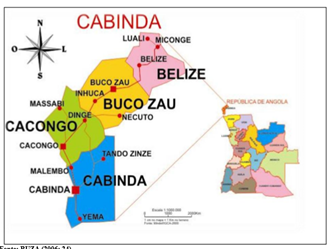Current status of Conocarpus erectus L., in the coastal sector of Cacongo, Cabinda province, Angola
Main Article Content
Abstract
The research was conducted in the period from November 2018 to November 2019, in the coastal sector Cacongo, Cabinda province, in a coastal protection area of 14 ha, with the objective of characterizing the status of the species Conocarpus erectus. Different dasometric parameters were evaluated: height (m), diameter (cm); basal area (m2) and volume (m3); as well as natural regeneration (incipient, established) and mortality (cut trees, dead trees and cut branches). With community participation, the main environmental problems affecting the species were determined by interviewing 65 people individually for 100 % and an observation guide was applied. The species was planted in the first line of the sea, where it does not adapt, it does not have an adequate development, the dynamics of natural regeneration is incipient with few established plants, with a state of the species in each plot that shows the following behavior: 44 dead trees, 134 cut trees and 110 cut branches. The main problems identified in the mangrove ecosystem were inadequate development (92 %), indiscriminate logging (85 %), diseases (74 %), coastal erosion (52 %), road and threshing construction (41 %), sea penetration (32 %) and water pollution (oil) (23 %).
Downloads
Article Details
References
CHARGOY, M.A.R. y HERNÁNDEZ, C.T., 2002. Restauración de áreas alteradas de manglar con Rhizophora mangle en la Costa de Chiapas. Madera y Bosques [en línea], vol. 8, pp. 103-114. [Consulta: 14 octubre 2020]. ISSN 2448-7597. DOI 10.21829/myb.2002.801294. Disponible en: https://myb.ojs.inecol.mx/index.php/myb/article/view/1294.
FAO, 2006. World Reference Base: Mapa Mundial de Suelos, escala 1: 30 000 000. S.l.: FAO, EC, ISRIC.
FAO, 2018. El estado de los bosques del mundo - Las vías forestales hacia el desarrollo sostenible. Roma: FAO.
GEILFUS, F., 1997. 80 herramientas para el desarrollo participativo: diagnóstico, planificación, monitoreo, evaluación [en línea]. S.l.: IICA. Disponible en: https://books.google.com.cu/books/about/80_herramientas_para_el_desarrollo_parti.html?hl=es&id=jVTUkFstuIIC&redir_esc=y.
GONZÁLEZ-HERNÁNDEZ, L., SOL-SÁNCHEZ, Á., PÉREZ-VÁZQUEZ, A., OBRADOR-OLAN, J.J., GONZÁLEZ-HERNÁNDEZ, L., SOL-SÁNCHEZ, Á., PÉREZ-VÁZQUEZ, A. y OBRADOR-OLAN, J.J., 2016. Sobrevivencia y crecimiento de mangle negro (Avicennia germinans L.) en plantaciones reforestadas y regeneración natural. Revista mexicana de ciencias agrícolas [en línea], vol. 7, no. SPE14, pp. 2769-2782. [Consulta: 14 octubre 2020]. ISSN 2007-0934. Disponible en: http://www.scielo.org.mx/scielo.php?script=sci_abstract&pid=S2007-09342016001002769&lng=es&nrm=iso&tlng=es.
GRAZIANO, J., 2018. Las vías forestales hacia el desarrollo sostenible de los bosques del mundo. FAO (Organización de las Naciones Unidas para la Alimentación y la Agricultura), ISSN 1020-5721.
GUZMÁN, J.M. y MENÉNDEZ, L., 2013. Protocolo para el monitoreo del ecosistema de manglar [en línea]. La Habana: Proyecto GEF/PNUD. ISBN 978-959-287-042-0. Disponible en: https://www.cifor.org/publications/pdf_files/WPapers/WP117Kauffman.pdf.
MARCELO, A., PINHEIRO, A. y CAROLINA, A. 2018. Educação Ambiental sobre Manguezais. 1ª Edição. Universidade Estadual Paulista "Júlio de Mesquita Filho" (UNESP) Instituto de Biociências (IB), Câmpus do Litoral Paulista (CLP). Brasil. ISBN: 978-85-61498-08-5, pp. 165. Disponible en: https://www.clp.unesp.br/Home/publicacoes/educacao-ambiental-sobre-manguezais.pdf
MORENO, P. y INFANTE, D., 2016. Conociendo los Manglares, las Selvas Inundables y los Humedales Herbáceos [en línea]. Primera edición. Disponible en: http://www.inecol.mx/inecol/libros/Conociendo_los_manglares,_ as_selvas_ pdf.
NÚÑEZ, F. y UGAS, M. 2018. Caracterización ûsionómica del manglar de Avicennia germinans y Conocarpus erectus emplazado en la Laguna de Unare, Venezuela Terra Nueva Etapa, vol. XXXIV, núm. 55, ISSN: 1012-7089, Universidad Central de Venezuela, Venezuela, pp. 21. Disponible en: http://www.redalyc.org/articulo.oa?id=72156172015.
ORJUELA-ROJAS, A.M., VILLAMIL, C.A. y SANJUAN-MUÑOZ, A., 2011. Extensión and structure of mangrove forests in the baja guajira, colombian caribbean. Boletín de Investigaciones Marinas y Costeras - INVEMAR [en línea], vol. 40, no. 2, pp. 381-399. [Consulta: 14 octubre 2020]. ISSN 0122-9761. Disponible en: http://www.scielo.org.co/scielo.php?script=sci_abstract&pid=S0122 -97612011000200009&lng=en&nrm=iso&tlng=es.
PINHEIRO, M. y TALAMONI, A., 2018. Educação ambiental sobre Manguezais. Ia Edição São Vicente [en línea]. S.l.: Universidade Estadual Paulista "Júlio de Mesquita Filho" (UNESP) Instituto de Biociências (IB), Câmpus do Litoral Paulista (CLP). ISBN 978-85-61498-08-5. Disponible en: https://www.clp.unesp.br/Home/publicacoes/educacao-ambiental-sobre-manguezais.pdf.
RAVELO, F.N. y PÉREZ, M.U., 2018. Caracterización fisionómica del manglar de Avicennia germinans y Conocarpus erectus emplazado en la Laguna de Unare, Venezuela. Terra. Nueva Etapa [en línea], vol. XXXIV, no. 55, pp. 193-218. [Consulta: 14 octubre 2020]. ISSN 1012-7089, 2542-3266. Disponible en: https://www.redalyc.org/articulo.oa?id=72156172015.
REYES, M. A. y TOVILLA, C., 2002. Restauración de áreas alteradas de manglar con Rhizophora mangle en la Costa de Chiapas. Revista Madera y Bosques, Vol. 8 Número especial 1. ISSN: 1405-0471, pp.103-114. Disponible en: https://www.redalyc.org/pdf/617/61709806.pdf
RODRÍGUEZ, O.L., 2016. Estado actual del bosque de manglar en el lote 2 de la Reserva Ecológica Baitiquirí, Guantánamo. Revista Cubana de Ciencias Forestales [en línea], vol. 4, no. 2, pp. 207-219. [Consulta: 14 octubre 2020]. ISSN 2310-3469. Disponible en: http://cfores.upr.edu.cu/index.php/cfores/article/view/203.
RODRÍGUEZ, O., FALCÓN, E., FERNÁNDEZ, M.C., RODRÍGUEZ, E. y ROMERO, C.V., 2014. Estado actual del bosque de manglar en el sector costero Caimanera. Revista electrónica «Hombre, Ciencia Tecnología», vol. 34, no. 71, pp. 10-25. ISSN 1028 08712014. Disponible en: https://dialnet.unirioja.es/descarga/articulo/5768628.pdf
RODRÍGUEZ, O.L., OCONOR, E.F., CASTILLO, C.V.R. y CRESPO, G. de la C.R., 2018. Propuesta de acciones para recuperar el bosque de manglar en la bahía de Guantánamo, Cuba. Revista Cubana de Ciencias Forestales [en línea], vol. 6, no. 2, pp. 224-239. [Consulta: 14 octubre 2020]. ISSN 2310-3469. Disponible en:http://cfores.upr.edu.cu/index.php/cfores/article/view/336.
SÁNCHEZ, J., 2017. Conocarpus erectus L. [en línea]. 2017. S.l.: PlanFor.es. Disponible en: http://www.arbolesornamentales.es.
SCHORHUTH, M. y KIEVELITZ, U., 1994. Diagnóstico Rural Rápido Participativo. Métodos de Diagnóstico y Planificación en la Cooperación al Desarrollo. S.l.: Gesellschaftfur Technische Zusammenarbeit. GTZ. GmbH.
VARGAS-FONSECA, E., 2015. Capacidad de regeneración natural del bosque de manglar del Estero Tortuga, Osa, Puntarenas, Costa Rica. Rev. biol. trop [en línea], pp. 209-218. [Consulta: 14 octubre 2020]. Disponible en: http://www.scielo.sa.cr/scielo.php?script=sci_arttext&pid=S0034-77442015000500209.
WALTERS, B.B., RÖNNBÄCK, P., KOVACS, J.M., CRONA, B., HUSSAIN, S.A., BADOLA, R., PRIMAVERA, J.H., BARBIER, E. y DAHDOUH-GUEBAS, F., 2008. Ethnobiology, socio-economics and management of mangrove forests: A review. Aquatic Botany [en línea], vol. 89, no. 2, pp. 220-236. [Consulta: 14 octubre 2020]. ISSN 0304-3770. DOI 10.1016/j.aquabot.2008.02.009. Disponible en: http://www.sciencedirect.com/science/article/pii/S0304377008000417.


